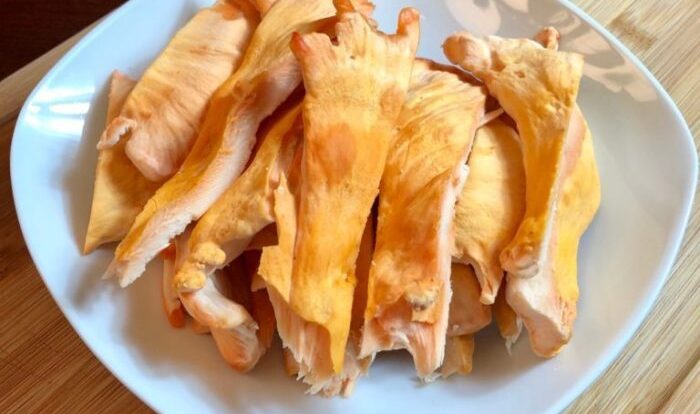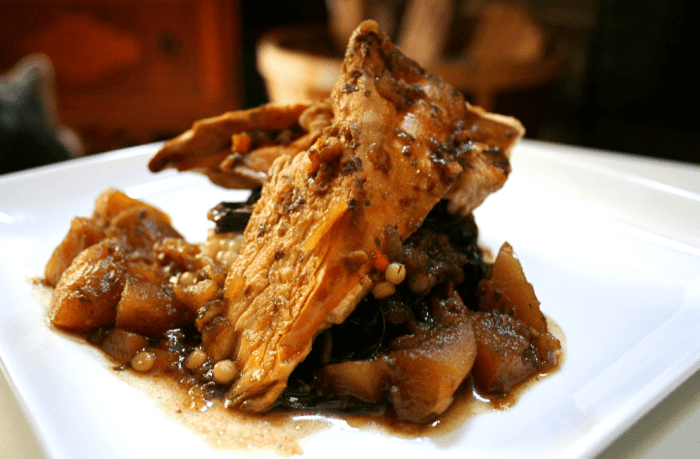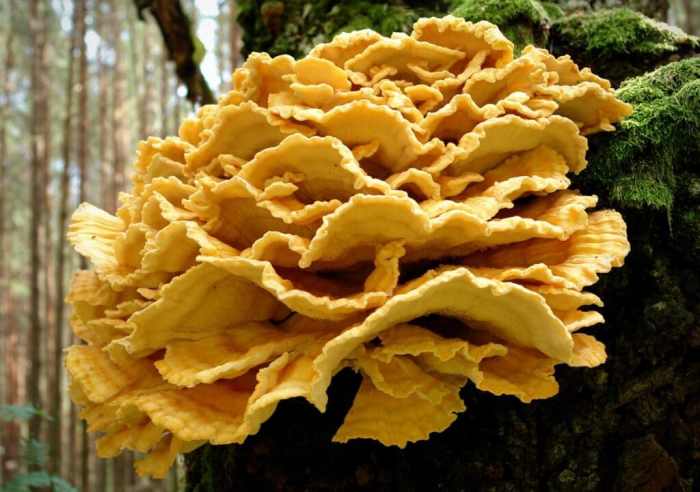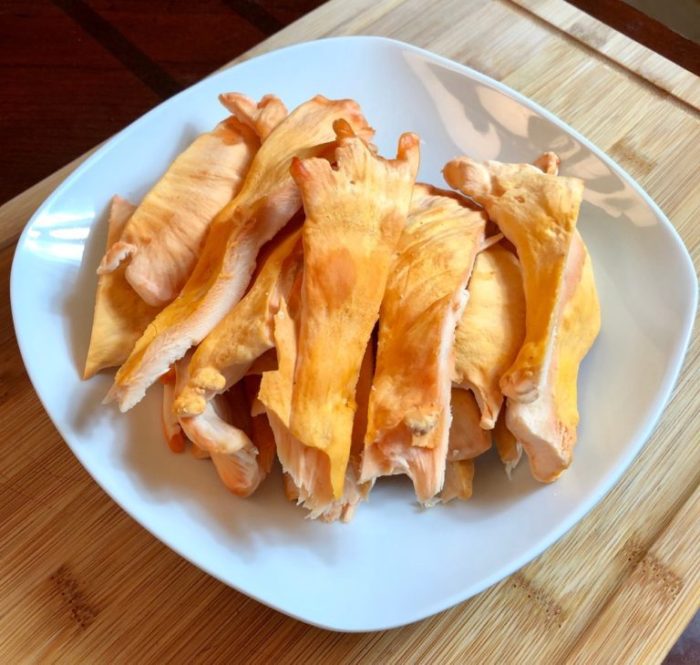
Welcome to the realm of culinary wonders, where the Chicken of the Woods Recipe reigns supreme. Get ready to embark on a delectable journey as we explore the versatile uses, nutritional benefits, and foraging techniques of this prized wild mushroom.
From sautéed delights to hearty soups, this guide will empower you to unlock the full potential of Chicken of the Woods in your kitchen.
In the heart of forests, on fallen logs and tree trunks, thrives the vibrant Chicken of the Woods, a mushroom with a captivating appearance and an equally captivating flavor. Its unique texture and earthy notes make it a culinary treasure, eagerly sought after by foragers and chefs alike.
Join us as we delve into the world of Chicken of the Woods, unlocking its secrets and inspiring you to create unforgettable dishes.
Culinary Applications of Chicken of the Woods
Chicken of the Woods is a versatile mushroom with a wide range of culinary applications. Its unique flavor and texture make it a popular choice for soups, stews, stir-fries, and more.
Chicken of the Woods has a meaty texture and a slightly sweet flavor. It is often compared to chicken or crab, making it a great substitute for meat in vegetarian and vegan dishes.
Preparation Techniques
Before cooking Chicken of the Woods, it is important to clean it thoroughly. Remove any dirt or debris from the surface of the mushroom, and then cut it into bite-sized pieces.
Chicken of the Woods can be cooked in a variety of ways. It can be sautéed, grilled, roasted, or fried. It is important to cook Chicken of the Woods thoroughly, as undercooked mushrooms can be tough and rubbery.
Flavor and Texture
Chicken of the Woods has a unique flavor and texture that makes it a popular choice for many dishes. Its meaty texture and slightly sweet flavor make it a great substitute for chicken or crab in vegetarian and vegan dishes.
Chicken of the Woods is also a good source of nutrients, including protein, fiber, and vitamins. It is a low-calorie food that is also low in fat and cholesterol.
If you’re looking for a delicious and easy-to-make vegetarian meal, look no further than the chicken of the woods recipe . This recipe uses fresh chicken of the woods mushrooms, which have a meaty texture and a slightly nutty flavor.
The mushrooms are simply sautéed in olive oil with garlic and thyme, and then served over pasta or rice.
Nutritional Benefits of Chicken of the Woods

Chicken of the Woods is a nutritionally rich mushroom that offers a range of health benefits. It is an excellent source of protein, fiber, and vitamins, making it a valuable addition to a healthy diet.Chicken of the Woods is a good source of protein, providing around 3 grams per 100 grams.
This protein is essential for building and repairing tissues, producing enzymes and hormones, and supporting immune function. Additionally, Chicken of the Woods is a good source of fiber, which helps to regulate digestion, promote satiety, and lower cholesterol levels.
If you’re looking for a delicious and unique vegetarian meal, look no further than the chicken of the woods recipe . This dish is made with a type of edible mushroom that has a texture similar to chicken. The mushrooms are cooked in a savory sauce and served over rice or pasta.
The chicken of the woods recipe is a great way to get your daily dose of vegetables and protein.
Vitamin Content, Chicken of the woods recipe
Chicken of the Woods is also a good source of vitamins, including vitamin C, vitamin D, and B vitamins. Vitamin C is an antioxidant that helps to protect cells from damage, while vitamin D is essential for bone health and immune function.
B vitamins are involved in a variety of bodily functions, including energy production, nerve function, and red blood cell formation.
Antioxidant and Anti-inflammatory Properties
In addition to its nutritional value, Chicken of the Woods also contains antioxidants and anti-inflammatory compounds. Antioxidants help to protect cells from damage caused by free radicals, while anti-inflammatory compounds can help to reduce inflammation throughout the body. These properties may contribute to the potential health benefits of consuming Chicken of the Woods, such as reducing the risk of chronic diseases like cancer and heart disease.
Comparison to Other Mushrooms
Compared to other types of mushrooms, Chicken of the Woods has a relatively high nutritional value. It is a good source of protein, fiber, and vitamins, and it contains antioxidants and anti-inflammatory compounds. This makes Chicken of the Woods a valuable addition to a healthy diet, and it can be enjoyed in a variety of dishes.
Foraging for Chicken of the Woods

Chicken of the Woods is a polypore fungus commonly found in deciduous forests. It typically grows in clusters on dead or dying trees, especially oak and maple. The fungus prefers warm and humid climates and is most abundant during the late summer and fall months.
Habitat and Growing Conditions
Chicken of the Woods prefers moist, shady areas with well-drained soil. It can be found on fallen logs, stumps, and the bases of living trees. The fungus forms large, shelf-like structures that can range in size from a few inches to over a foot in diameter.
The upper surface of the mushroom is typically orange or yellow, while the underside is white or cream-colored.
Identifying Chicken of the Woods
When foraging for Chicken of the Woods, it is important to be able to identify the mushroom correctly. The fungus has a distinctive appearance that sets it apart from other similar-looking species. The following characteristics can help you identify Chicken of the Woods:
- Color: The upper surface of the mushroom is typically orange or yellow, while the underside is white or cream-colored.
- Shape: The mushroom forms large, shelf-like structures that can range in size from a few inches to over a foot in diameter.
- Texture: The flesh of the mushroom is firm and meaty, with a slightly rubbery texture.
- Smell: Chicken of the Woods has a mild, fruity smell that is similar to apricots or peaches.
Responsible Foraging Practices
When foraging for Chicken of the Woods, it is important to follow responsible foraging practices to ensure the sustainability of the resource. Here are some tips for responsible foraging:
- Only harvest mushrooms that you are certain you can identify correctly.
- Never harvest more mushrooms than you need.
- Avoid harvesting mushrooms from areas that have been treated with pesticides or herbicides.
- Be sure to leave the base of the mushroom intact so that it can continue to produce fruit.
Avoiding Poisonous Mushrooms
It is important to be aware of the potential dangers of eating poisonous mushrooms. If you are not sure whether a mushroom is safe to eat, it is best to err on the side of caution and avoid it. Some poisonous mushrooms can be very similar in appearance to edible mushrooms, so it is important to be able to identify the key differences between the two.One
of the most important things to look for when identifying poisonous mushrooms is the presence of gills. Gills are the thin, blade-like structures that are found on the underside of the mushroom cap. Most poisonous mushrooms have gills, while edible mushrooms typically have pores or tubes.Another
important thing to look for is the presence of a volva. A volva is a cup-shaped structure that surrounds the base of the mushroom stem. Many poisonous mushrooms have a volva, while edible mushrooms typically do not.If you are ever in doubt about whether a mushroom is safe to eat, it is best to consult with a qualified expert.
Chicken of the Woods Recipes

Chicken of the woods is a versatile mushroom that can be used in a variety of dishes. It has a meaty texture and a slightly nutty flavor, making it a great substitute for chicken in many recipes.
Here are a few recipes for cooking chicken of the woods:
Sautéed Chicken of the Woods
- Ingredients:
- 1 pound chicken of the woods mushrooms, cleaned and sliced
- 1 tablespoon olive oil
- 1/2 onion, chopped
- 2 cloves garlic, minced
- 1/2 teaspoon dried thyme
- 1/4 teaspoon salt
- 1/4 teaspoon black pepper
- Instructions:
- Heat the olive oil in a large skillet over medium heat.
- Add the mushrooms, onion, and garlic to the skillet and cook until softened, about 5 minutes.
- Stir in the thyme, salt, and pepper.
- Cook for an additional 2-3 minutes, or until the mushrooms are cooked through.
- Serve immediately.
Chicken of the Woods Soup or Stew
- Ingredients:
- 1 pound chicken of the woods mushrooms, cleaned and sliced
- 1 tablespoon olive oil
- 1 onion, chopped
- 2 cloves garlic, minced
- 2 cups vegetable broth
- 1 cup water
- 1/2 teaspoon dried thyme
- 1/4 teaspoon salt
- 1/4 teaspoon black pepper
- Instructions:
- Heat the olive oil in a large pot over medium heat.
- Add the mushrooms, onion, and garlic to the pot and cook until softened, about 5 minutes.
- Stir in the vegetable broth, water, thyme, salt, and pepper.
- Bring to a boil, then reduce heat and simmer for 20 minutes, or until the mushrooms are cooked through.
- Serve immediately.
Chicken of the Woods Substitutes

Chicken of the woods is a unique mushroom with a distinct flavor and texture. However, it’s not always easy to find, especially if you’re not an experienced forager. If you’re looking for a substitute for chicken of the woods, there are a few other mushrooms that can come close.
Flavor and Texture
Chicken of the woods has a meaty, slightly chewy texture and a slightly sweet, earthy flavor. When cooked, it takes on a slightly crispy exterior and a tender interior. Some good substitutes for chicken of the woods include:
- Oyster mushrooms: Oyster mushrooms have a similar meaty texture to chicken of the woods, but they have a milder flavor. They’re also very versatile and can be used in a variety of dishes.
- King oyster mushrooms: King oyster mushrooms are larger than regular oyster mushrooms and have a more pronounced meaty flavor. They’re a good choice for dishes where you want the mushroom to be the star of the show.
- Maitake mushrooms: Maitake mushrooms have a slightly chewy texture and a nutty, slightly sweet flavor. They’re a good choice for dishes where you want a more subtle mushroom flavor.
Availability
Chicken of the woods is a seasonal mushroom that is typically found in the late summer and fall. However, it can be difficult to find, especially if you’re not an experienced forager. Oyster mushrooms and king oyster mushrooms are more widely available and can be found in most grocery stores.
Maitake mushrooms are less common, but they can be found in some specialty grocery stores.
| Mushroom | Flavor | Texture | Availability |
|---|---|---|---|
| Chicken of the woods | Meaty, slightly sweet, earthy | Slightly chewy | Seasonal, difficult to find |
| Oyster mushrooms | Milder, slightly sweet | Meaty | Versatile, widely available |
| King oyster mushrooms | More pronounced meaty flavor | Meaty | More widely available than regular oyster mushrooms |
| Maitake mushrooms | Nutty, slightly sweet | Slightly chewy | Less common, but available in specialty grocery stores |
Ending Remarks: Chicken Of The Woods Recipe

As we bid farewell to the world of Chicken of the Woods, let us savor the memories of its culinary delights. Whether you’re a seasoned forager or a home cook seeking new adventures, this guide has equipped you with the knowledge and inspiration to embrace the wonders of this wild mushroom.
From its nutritional value to its versatility in the kitchen, Chicken of the Woods stands as a testament to nature’s bounty. So, venture into the forests, embrace the thrill of the hunt, and let the Chicken of the Woods guide you to culinary greatness.
Key Questions Answered
What is the best way to clean Chicken of the Woods?
Gently brush off any dirt or debris with a soft brush or cloth. Avoid washing it directly with water, as it can absorb moisture and lose its flavor.
How can I identify Chicken of the Woods in the wild?
Look for its distinctive bright orange or yellow color, shelf-like shape, and velvety texture. Its underside features tiny pores instead of gills.
Is Chicken of the Woods safe to eat raw?
No, it’s not recommended to consume Chicken of the Woods raw. Cooking it properly ensures its safety and enhances its flavor and texture.





